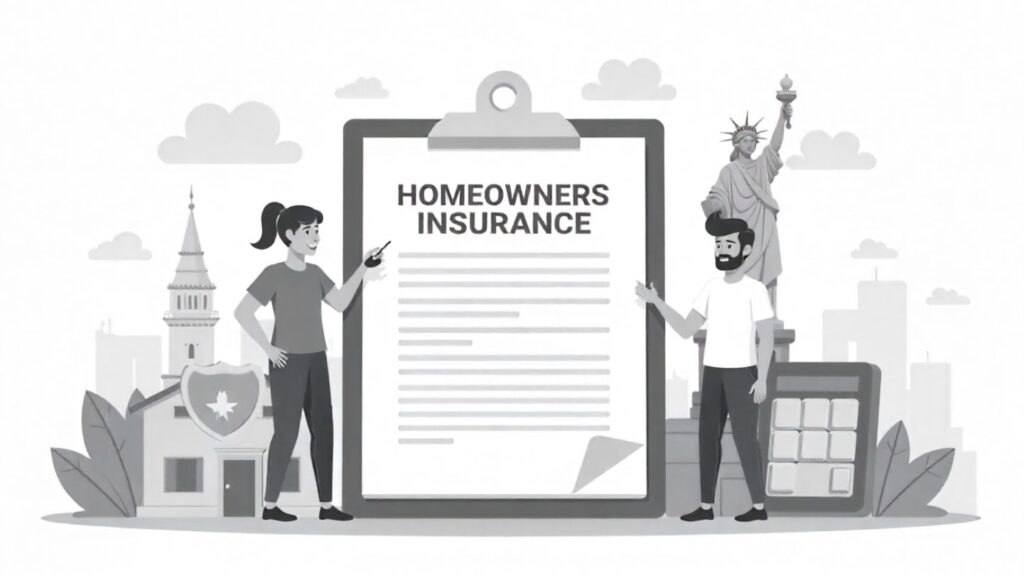- What Is Homeowners Insurance in the USA?
- What Does Homeowners Insurance Cover?
- What Homeowners Insurance Does Not Cover (Exclusions)
- Average Cost of Homeowners Insurance in the USA
- Types of Homeowners Insurance Policies
- Replacement Cost vs Actual Cash Value
- How to Choose the Right Homeowners Insurance Policy
- Discounts and Ways to Save on Homeowners Insurance
- Best Homeowners Insurance Companies in the USA
- Conclusion
- FAQs
Homeowners insurance provides essential financial protection for property owners in the USA. It helps cover the cost of repairs or rebuilding after damage, replaces stolen or destroyed belongings, and offers liability coverage if someone is injured on your property.
Having this insurance matters because unexpected events like fires, storms, or theft can cause significant financial hardship. Without coverage, homeowners risk paying thousands out of pocket.
This guide explains who needs homeowners insurance, the types of coverage available, how to choose the right policy, and tips to save money. It aims to help you make informed decisions and protect your home effectively.
What Is Homeowners Insurance in the USA?
Homeowners insurance in the USA is a contract between a homeowner and an insurance company that provides financial protection against damage to the home, its contents, and liability for injuries or accidents occurring on the property. It helps cover repair or rebuilding costs, replacement of personal belongings, and legal expenses related to property incidents.
The primary purpose of homeowners insurance is to reduce the financial burden caused by unexpected events such as fires, storms, theft, or accidents. Without this coverage, homeowners would need to pay for damages and losses out of pocket, which can be costly.
While homeowners insurance is not mandated by law, mortgage lenders generally require borrowers to maintain an active policy as a condition of the loan. This requirement ensures the lender’s investment is protected in case the property sustains damage.
Even if you own your home outright, having insurance is advisable to safeguard your financial security and help recover after covered losses.
What Does Homeowners Insurance Cover?
Homeowners insurance in the USA typically provides a well-rounded layer of protection that covers your home, personal belongings, and certain legal or temporary living expenses. Here’s a closer look at what standard policies generally include.
Dwelling Coverage
This is the foundation of a homeowners policy. It helps pay to repair or rebuild the structure of your home if it is damaged by a covered event such as a fire, hailstorm, or falling tree. It usually covers the house itself, along with built-in features like plumbing, electrical systems, flooring, and roofing.
The amount of coverage should reflect the cost to fully rebuild the home using current construction prices in your area.
Personal Property Coverage
If your belongings are damaged, destroyed, or stolen due to a covered incident, personal property coverage can help you replace them. This includes furniture, electronics, clothing, appliances, and other household items.
Some high-value items like jewelry, collectibles, or fine art may have limited coverage unless you add a scheduled endorsement. Creating a home inventory can help ensure you carry enough protection.
Liability Protection
This part of the policy helps cover legal and medical costs if someone is injured on your property and you are found responsible. It may also apply if your pet bites someone or if you accidentally cause damage to someone else’s property.
Liability coverage can be especially important for avoiding out-of-pocket legal expenses or settlements.
Loss of Use (Additional Living Expenses)
If your home becomes uninhabitable due to a covered event, this coverage can help pay for temporary living costs while repairs are being made. That might include hotel bills, short-term rentals, restaurant meals, and even pet boarding. It helps maintain your standard of living during a difficult time.
Other Structures
In addition to the main house, homeowners insurance often includes protection for other structures on your property. This can cover detached garages, fences, storage sheds, or gazebos. Like dwelling coverage, these structures must be damaged by a covered cause of loss for the policy to pay out.
What Homeowners Insurance Does Not Cover (Exclusions)
Homeowners insurance policies provide broad protection, but they do not cover every possible situation. Understanding common exclusions helps homeowners avoid surprises when filing a claim. Here are key areas typically not covered by standard policies.
Floods and Earthquakes
Most homeowners insurance policies exclude damage caused by floods or earthquakes. These natural disasters require separate insurance policies or endorsements because their risks and costs differ significantly from other perils.
In many regions, you can purchase flood insurance through the National Flood Insurance Program or private insurers, and earthquake insurance may be available depending on your location.
Wear and Tear
Insurance policies do not cover damage that results from normal aging, deterioration, or lack of maintenance. For example, if your roof leaks because it is old and has not been repaired, the policy usually will not pay for the damage. Homeowners are responsible for routine upkeep to prevent such losses.
Pest Infestations
Damage from pests like termites, rodents, or carpenter ants is generally excluded. Since infestations develop over time, insurance companies expect homeowners to manage pest control and repairs. Some specialized policies may offer limited pest coverage, but it is rare.
Government Seizure or War
Losses caused by government actions such as property seizure or destruction, or by acts of war and nuclear hazards, are typically excluded. These events fall outside the scope of standard homeowners insurance due to their unique and large-scale nature.
Average Cost of Homeowners Insurance in the USA
The average cost of homeowners insurance in the USA typically ranges from $1,200 to $1,500 per year as of 2025. However, the exact price depends heavily on factors such as the state you live in, the size and value of your home, and the level of coverage you select.
Cost varies by state and region. For example, homeowners in states prone to natural disasters like hurricanes or wildfires often pay higher premiums. Florida, Louisiana, and Texas tend to have above-average insurance costs due to hurricane risks.
In contrast, states like Idaho, Oregon, and Vermont usually have lower average premiums. Urban areas with higher crime rates may also see increased costs compared to rural locations.
Several factors influence homeowners insurance costs:
- Location: Risk zones such as flood plains, wildfire-prone areas, or high-crime neighborhoods increase premiums.
- Home value and size: Larger or more expensive homes require higher coverage limits, which raise the policy cost.
- Credit score: Insurers often use credit-based insurance scores to assess risk, with better scores leading to lower rates.
- Claims history: A record of past insurance claims can result in higher premiums because it indicates increased risk.
- Deductible amount: Choosing a higher deductible lowers your premium but means you pay more out-of-pocket when filing a claim.
By understanding these factors, homeowners can better estimate their insurance costs and shop for the best policy to fit their budget and protection needs.
Types of Homeowners Insurance Policies
Homeowners insurance policies come in several forms, each offering different levels of coverage designed to meet diverse needs. Understanding the common policy types helps you select the one that fits your home and budget best.
HO-1 (Basic Named Perils)
This policy provides coverage for a limited set of risks, such as fire, lightning, and theft. It is rarely used today because it offers minimal protection compared to other policy types.
HO-2 (Broad Named Perils)
HO-2 covers a broader range of named risks, including damage from storms, falling objects, and water damage from plumbing leaks. It suits budget-conscious homeowners who want more protection than HO-1 without the cost of comprehensive policies.
HO-3 (Special Form)
The most common type of homeowners insurance, HO-3 covers the dwelling against all perils except those specifically excluded in the policy. Personal property coverage is limited to named perils. This policy balances broad protection with affordability.
HO-5 (Comprehensive Form)
HO-5 policies provide open-peril coverage for both the home and personal belongings, meaning all risks are covered unless excluded. This policy is ideal for owners of high-value homes or those with expensive personal property.
HO-6 (Condo Insurance)
Designed specifically for condominium owners, HO-6 covers the interior of the unit and personal property. It often includes liability protection and loss of use coverage but does not cover the building’s exterior or common areas.
HO-7 (Mobile Home Insurance)
This policy is tailored for manufactured or mobile homes. It provides similar coverage to HO-3 but is adapted to the unique risks associated with mobile homes.
HO-8 (Older Home Insurance)
HO-8 policies cover homes that may not meet modern building codes or are difficult to replace. Coverage is usually based on the actual cash value of the home rather than replacement cost, making it suitable for older or historic properties.
Replacement Cost vs Actual Cash Value
When choosing homeowners insurance, understanding the difference between replacement cost and actual cash value is essential because it affects how much you receive when filing a claim.
Replacement Cost
Replacement cost coverage pays the full amount needed to repair or rebuild your home or replace your belongings without subtracting for depreciation. For example, if your roof is damaged and would cost $20,000 to replace today, replacement cost coverage will pay that full amount, regardless of the roof’s age or wear.
Actual Cash Value (ACV)
Actual cash value coverage pays to repair or replace property minus depreciation based on age, condition, and wear. Using the same roof example, if the damaged roof is 10 years old and has depreciated in value, the insurer might only pay $12,000 rather than the full $20,000 replacement cost.
Why Replacement Cost Is Usually Better
Replacement cost coverage provides better financial protection by allowing you to restore your home or belongings to their original condition without paying the difference out of pocket. This can be especially important when rebuilding after a major disaster or replacing expensive personal property.
Impact on Claims and Premiums
Policies with replacement cost coverage often come with higher premiums because they provide more extensive protection. Actual cash value policies may be cheaper but leave homeowners responsible for the difference when replacing older items or repairing damage. Carefully considering your budget and risk tolerance will help you decide which option is best.
How to Choose the Right Homeowners Insurance Policy
Choosing the right homeowners insurance policy involves more than just picking the cheapest option. To ensure you have adequate protection, follow this step-by-step checklist.
Estimate the Rebuild Cost
Calculate the cost to rebuild your home in today’s market. This includes materials, labor, and permits. Avoid using your home’s market value, which can be higher due to land value. Accurate rebuilding cost estimation helps set appropriate dwelling coverage limits.
Inventory Your Personal Property
Make a detailed list of your belongings, including furniture, electronics, clothing, and valuables. This helps determine how much personal property coverage you need. Include purchase dates, costs, and photos if possible to support future claims.
Compare Quotes from Multiple Providers
Request quotes from at least three insurance companies. Compare not only price but also coverage limits, exclusions, deductibles, and customer service ratings. Online tools and independent agents can assist in finding competitive options.
Evaluate Your Liability Needs
Consider your financial situation and assets when choosing liability coverage. If you own significant assets, higher liability limits or umbrella insurance may provide extra protection against lawsuits.
Understand Deductible Tradeoffs
A higher deductible typically lowers your premium but increases your out-of-pocket costs after a claim. Choose a deductible amount that balances affordability with your ability to cover unexpected expenses.
Account for Local Risk Factors
Assess risks specific to your area such as flood zones, wildfire-prone regions, or hurricane exposure. You may need additional policies or endorsements for these hazards since they are usually excluded from standard coverage.
Discounts and Ways to Save on Homeowners Insurance
Saving money on homeowners insurance is possible by taking advantage of various discounts and making smart choices. Here are some effective ways to reduce your premiums without sacrificing important coverage.
Bundle with Auto Insurance
Many insurance companies offer discounts when you purchase both home and auto policies from them. Bundling your policies can save you 10 to 25 percent on your total premiums while simplifying your billing and claims process.
Install Smart Home Devices
Equipping your home with smart security systems, smoke detectors, or water leak sensors may qualify you for discounts. These devices reduce risk by alerting you early to potential problems, making your home safer and less likely to experience costly damage.
Loyalty and Claim-Free Discounts
Insurers often reward customers who stay with them for several years or have a history free of claims. Maintaining a good claims record can lead to lower rates over time.
Raise Your Deductible for Lower Premiums
Choosing a higher deductible reduces your monthly or annual premium because you agree to pay more out-of-pocket in case of a claim. This approach works well if you have enough savings to cover the deductible in an emergency.
Shop Annually for Better Rates
Insurance rates and offers can change yearly. Reviewing and comparing quotes every year ensures you are not overpaying and helps you take advantage of new discounts or promotions.
Best Homeowners Insurance Companies in the USA
Several large insurance companies consistently rank among the top providers of homeowners insurance in the USA. These include State Farm, Allstate, Liberty Mutual, and USAA. Each company offers a variety of coverage options, discounts, and customer service experiences, making it important to compare them carefully before choosing a policy.
When evaluating insurance companies, consider the following factors:
Financial Strength
Look for insurers with strong financial ratings from independent agencies such as A.M. Best or Standard & Poor’s. A high rating indicates the company has the resources to pay claims promptly and remain stable over time.
Customer Reviews and Satisfaction
Research customer feedback through online reviews and surveys. Companies with higher customer satisfaction scores tend to provide better claims handling and overall service.
Coverage Options and Discounts
Compare the range of policy options, endorsements, and discounts each insurer offers. Some may provide additional coverages that suit your needs or unique discounts that help lower premiums.
Claims Process
A smooth, transparent claims process is crucial. Check how easy it is to file claims, how quickly they are processed, and how well the company communicates throughout the process.
Conclusion
Homeowners insurance plays a crucial role in protecting your home, belongings, and financial well-being from unexpected events. Regularly reviewing your policy ensures it keeps pace with changes such as renovations or new purchases. Shopping around each year helps you find the best coverage at competitive rates.
Finally, maintaining a detailed record of your belongings and home improvements can simplify the claims process and ensure you receive fair compensation when needed. Taking these steps will give you greater peace of mind and stronger protection for your most valuable asset.
FAQs
How much is homeowners insurance in the USA?
Homeowners insurance usually costs between $1,200 and $1,500 per year. The exact amount depends on factors such as your location, the value of your home, and the coverage limits you choose.
What is not covered by homeowners insurance?
Standard policies typically exclude coverage for floods, earthquakes, pest damage, and normal wear and tear. To protect against these risks, you may need to purchase separate policies or endorsements.
Do I need homeowners insurance if I own my home outright?
While it is not required by law, carrying homeowners insurance is highly recommended. Without it, you are fully responsible for repair costs and liability claims, which can be financially burdensome.
Can I bundle homeowners and auto insurance?
Yes. Many major insurance companies offer discounts when you bundle home and auto insurance policies. This can reduce your premiums by 10 to 25 percent.
What is the difference between HO-3 and HO-5 policies?
HO-3 policies cover all risks for the home structure but only named perils for personal belongings. HO-5 policies provide all-risk coverage for both the home and belongings, making them a better choice for high-value homes.



